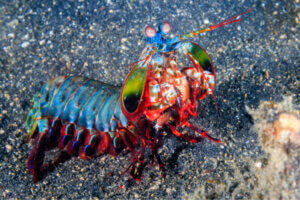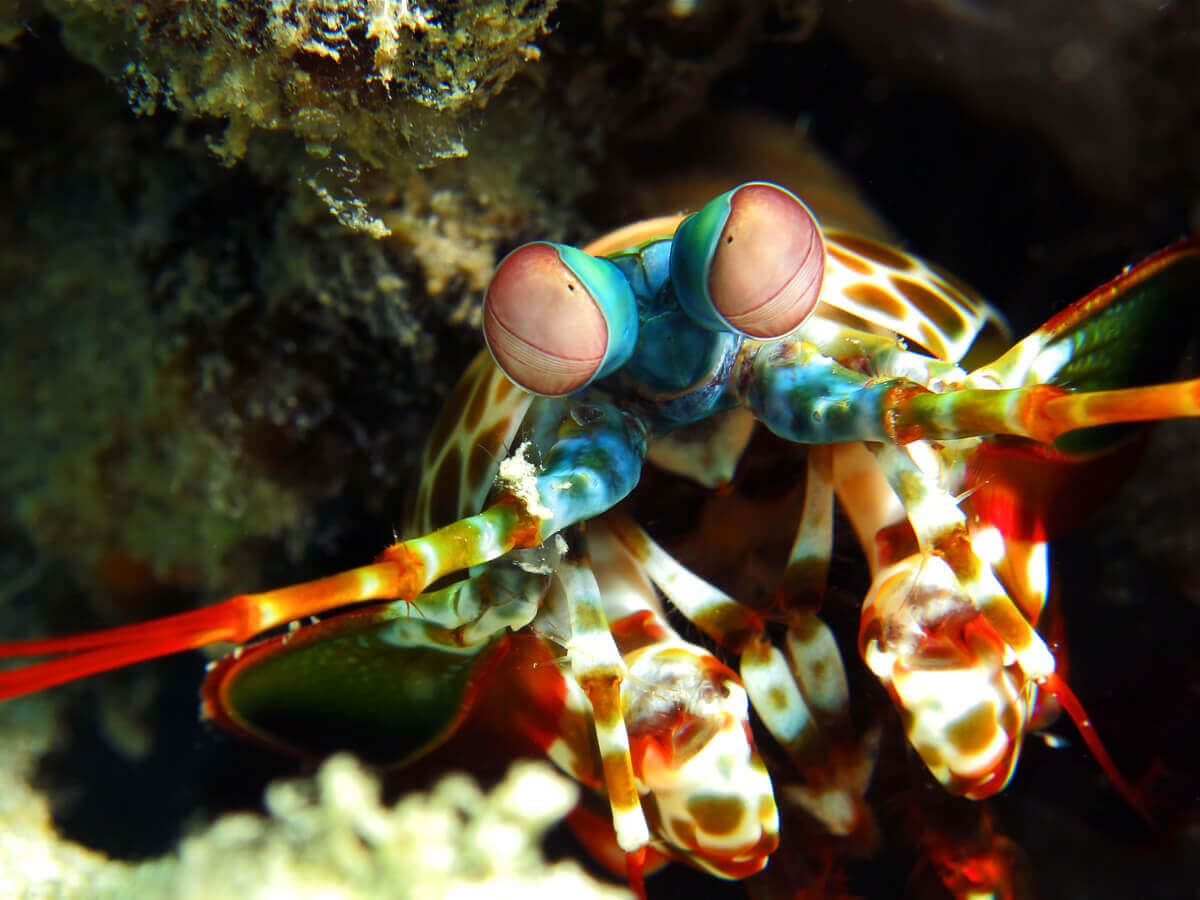Discover the Invincible Mantis Shrimp


Written and verified by biochemistry Luz Eduviges Thomas-Romero
Shrimp come in a variety of sizes, varying between 5 and 16 inches, approximately. And when it comes to their coloration, they also vary from brown to bolder and even fluorescent colors. One of the more eye-catching varieties is the mantis shrimp.
These invertebrate crustaceans belong to the Stomatopoda order, which includes some 400 different mantis shrimp species. All of these species also belong to the suborder Unipeltata. In general, we refer to them by a variety of names: Sea locusts, prawn killers, and even thumb splitters.
Ready for a fight
Mantis shrimp are aggressive predator animals that possess powerful claws. We’re referring to a pair of modified thoracic appendages in the shape of forceps, similar to those of the praying mantis. According to the shape of these claws, there are two different groups:
- Spearers possess spiny appendages that end in punts with quills or spears. They’re able to stab through their prey with strength and speed.
- Smashers possess appendages that are more like clubs, with a rudimentary quill. Shrimp in this category use their clubs to beat and crush their prey. For this reason, many know them as boxer mantises–because they’re such good hitters. They also possess a sharp border on one end that helps them cut their prey.
Thanks to their speed and ferociousness, both types of mantises are able to overcome prey that’s much larger than themselves. In fact, there are reports of mantises capturing prey eight times their own size.

The science behind the punch
Without a doubt, the key to the punch of these crustaceans is speed, as being fast underwater is an elaborate process. To achieve it, besides normal muscles, their arms contain special structures that allow them to quickly store and release energy through brutal blows. Their appendages possess a sort of muscular spring.
The blunt blows of these shrimp species can measure up to a speed of 75 feet per second (about 50 mph).
The appendage that carries the club in mantis shrimps possesses an elastic structure in the shape of a saddle. This structure compresses and shoots thanks to the simultaneous contraction of the extensor and flexor muscles. At just the right moment, it releases the latch by relaxing the flexor muscles, which allows the outward movement of the club.
If the prey doesn’t die from the blow, it will die of fright
Scientists have determined that, thanks to the speed of the blow, the attacker produces cavitation bubbles. It’s interesting to note that cavitation is a hydrodynamic effect that produces bubbles when a liquid is subjected to forces that respond to pressure differences.
So, the resulting bubbles travel to areas of greater pressure and implode. In other words, the vapor returns to its liquid state suddenly and the bubbles burst abruptly. Therefore, it releases a great deal of energy that can crack any surface upon impact. This phenomenon usually involves noise and vibration as well.
Experts suppose that the collapsing of these cavitation bubbles produces a force that creates a double blow to the prey. So, even if the original blow fails, the impact created by the cavitation bubbles will be enough to stun or even kill the prey.
If the blow is so powerful, why doesn’t the shrimp break its club?
In order to deal such powerful blows without breaking their claws, mantis shrimp have a special cushioning nucleus that possesses a unique molecular structure. No other animal known to man presents this same molecular structure.
So, their great resistance to impact is thanks to what’s called the Bouligand Structure. This is similar to an outer layer of plywood. In short, the claws of these crustaceans possess two layers:
- The superior layer consists of mineralized bioceramic material that’s similar to bone. The inferior layer is fibrous, like a rope.
- The internal layer, which is stronger when it stretches, provides necessary flexible support. Without it, the blows would damage the crustacean.
Different hunting strategies for different weapons
It’s worth noting that most mantis shrimp aren’t smashers, but rather spearers. Each type possesses different hunting styles, which we’ll show you below.
Spearers hunt by leaving their dens and searching for sedentary prey with hard shells. They then hit them in order to expose their soft and flavorful interior. Additionally, spearers trap fish, shrimp, and even shark offspring.
On the other hand, smashers are more prone to ambush their prey. Most often, they trap their prey by hiding silently in their den until an animal comes within reach. They use their ability to attack snails, mollusks, oysters, and crabs.

As you can see, the world of mantis shrimp is much more intricate than many could imagine. Just the same, one thing is clear. It’s best to stay away from this animal when it’s ready to attack its prey or you may end up with a broken bone.
Shrimp come in a variety of sizes, varying between 5 and 16 inches, approximately. And when it comes to their coloration, they also vary from brown to bolder and even fluorescent colors. One of the more eye-catching varieties is the mantis shrimp.
These invertebrate crustaceans belong to the Stomatopoda order, which includes some 400 different mantis shrimp species. All of these species also belong to the suborder Unipeltata. In general, we refer to them by a variety of names: Sea locusts, prawn killers, and even thumb splitters.
Ready for a fight
Mantis shrimp are aggressive predator animals that possess powerful claws. We’re referring to a pair of modified thoracic appendages in the shape of forceps, similar to those of the praying mantis. According to the shape of these claws, there are two different groups:
- Spearers possess spiny appendages that end in punts with quills or spears. They’re able to stab through their prey with strength and speed.
- Smashers possess appendages that are more like clubs, with a rudimentary quill. Shrimp in this category use their clubs to beat and crush their prey. For this reason, many know them as boxer mantises–because they’re such good hitters. They also possess a sharp border on one end that helps them cut their prey.
Thanks to their speed and ferociousness, both types of mantises are able to overcome prey that’s much larger than themselves. In fact, there are reports of mantises capturing prey eight times their own size.

The science behind the punch
Without a doubt, the key to the punch of these crustaceans is speed, as being fast underwater is an elaborate process. To achieve it, besides normal muscles, their arms contain special structures that allow them to quickly store and release energy through brutal blows. Their appendages possess a sort of muscular spring.
The blunt blows of these shrimp species can measure up to a speed of 75 feet per second (about 50 mph).
The appendage that carries the club in mantis shrimps possesses an elastic structure in the shape of a saddle. This structure compresses and shoots thanks to the simultaneous contraction of the extensor and flexor muscles. At just the right moment, it releases the latch by relaxing the flexor muscles, which allows the outward movement of the club.
If the prey doesn’t die from the blow, it will die of fright
Scientists have determined that, thanks to the speed of the blow, the attacker produces cavitation bubbles. It’s interesting to note that cavitation is a hydrodynamic effect that produces bubbles when a liquid is subjected to forces that respond to pressure differences.
So, the resulting bubbles travel to areas of greater pressure and implode. In other words, the vapor returns to its liquid state suddenly and the bubbles burst abruptly. Therefore, it releases a great deal of energy that can crack any surface upon impact. This phenomenon usually involves noise and vibration as well.
Experts suppose that the collapsing of these cavitation bubbles produces a force that creates a double blow to the prey. So, even if the original blow fails, the impact created by the cavitation bubbles will be enough to stun or even kill the prey.
If the blow is so powerful, why doesn’t the shrimp break its club?
In order to deal such powerful blows without breaking their claws, mantis shrimp have a special cushioning nucleus that possesses a unique molecular structure. No other animal known to man presents this same molecular structure.
So, their great resistance to impact is thanks to what’s called the Bouligand Structure. This is similar to an outer layer of plywood. In short, the claws of these crustaceans possess two layers:
- The superior layer consists of mineralized bioceramic material that’s similar to bone. The inferior layer is fibrous, like a rope.
- The internal layer, which is stronger when it stretches, provides necessary flexible support. Without it, the blows would damage the crustacean.
Different hunting strategies for different weapons
It’s worth noting that most mantis shrimp aren’t smashers, but rather spearers. Each type possesses different hunting styles, which we’ll show you below.
Spearers hunt by leaving their dens and searching for sedentary prey with hard shells. They then hit them in order to expose their soft and flavorful interior. Additionally, spearers trap fish, shrimp, and even shark offspring.
On the other hand, smashers are more prone to ambush their prey. Most often, they trap their prey by hiding silently in their den until an animal comes within reach. They use their ability to attack snails, mollusks, oysters, and crabs.

As you can see, the world of mantis shrimp is much more intricate than many could imagine. Just the same, one thing is clear. It’s best to stay away from this animal when it’s ready to attack its prey or you may end up with a broken bone.
All cited sources were thoroughly reviewed by our team to ensure their quality, reliability, currency, and validity. The bibliography of this article was considered reliable and of academic or scientific accuracy.
- Tadayon, M., Amini, S., Wang, Z., & Miserez, A. (2018). Biomechanical design of the mantis shrimp saddle: a biomineralized spring used for rapid raptorial strikes. iScience, 8, 271-282.
- DeVries, M. S., Murphy, E. A. K., & Patek, S. N. (2012). Strike mechanics of an ambush predator: the spearing mantis shrimp. Journal of Experimental Biology, 215(24), 4374-4384.
- Abelló, P., & Guerao, G. (2015). Orden Stomatopoda. Revista IDE@–SEA, 84, 1-10. http://sea-entomologia.org/IDE@/revista_84.pdf
- Sakes, A., van der Wiel, M., Henselmans, P. W., van Leeuwen, J. L., Dodou, D., & Breedveld, P. (2016). Shooting mechanisms in nature: a systematic review. PLoS One, 11(7).
This text is provided for informational purposes only and does not replace consultation with a professional. If in doubt, consult your specialist.








